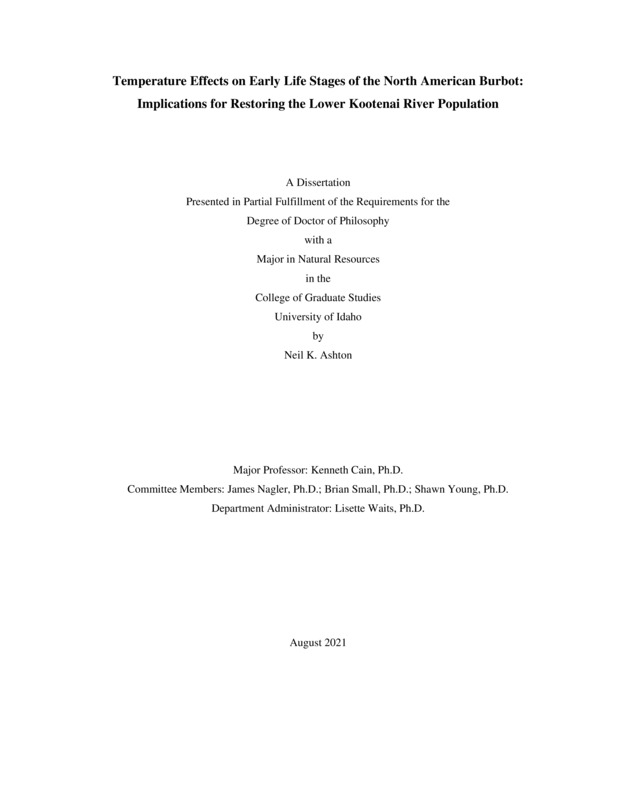Temperature Effects on Early Life Stages of the North American Burbot: Implications for Restoring the Lower Kootenai River Population
Ashton, Neil. (2021-08). Temperature Effects on Early Life Stages of the North American Burbot: Implications for Restoring the Lower Kootenai River Population. Theses and Dissertations Collection, University of Idaho Library Digital Collections. https://www.lib.uidaho.edu/digital/etd/items/ashton_idaho_0089e_12142.html
- Title:
- Temperature Effects on Early Life Stages of the North American Burbot: Implications for Restoring the Lower Kootenai River Population
- Author:
- Ashton, Neil
- Date:
- 2021-08
- Program:
- Natural Resources
- Subject Category:
- Aquatic sciences
- Abstract:
-
An imperiled population of endemic North American Burbot (Lota lota maculosa) inhabiting the lower Kootenai River in a transboundary region of Idaho and British Columbia struggles with recruitment failures linked to incompatibility between early life history patterns and upstream hydropower operations at Libby Dam in Montana. The loss of both river ice in winter and a flood pulse in spring has led to an unnatural post-dam thermal regime in spawning and early rearing habitats of Burbot. A series of laboratory experiments and river temperature modeling efforts were carried out to determine if simulated changes to the river thermal regime impact spawning, embryo development, and larval rearing. Contemporary warming in the post-dam regime between December−January does not appear to preclude functional gametogenesis, as river-adapted hatchery fish spawned viable gametes in February. However, elevated water temperatures of 4°C and 6°C shorten the spawning period to potentially coincide with suboptimal conditions for normal embryo development. Cold incubation temperatures are crucial during early embryogenesis, but the post-dam regime is often >3°C—and can be as warm as 5°C—which causes severe deformity and mortality of embryos. Later stages of embryonic development show reasonable tolerance to gradual warming and moderate thermal flux common in late winter and early spring. Larvae were observed inflating their swim bladders, foraging on rotifers, and exhibiting high survival through a critical period in waters <6°C, which is the typical post-dam condition in putative nursery habitats in April. However, such cold regimes also prolong resting behavior of yolk-sac larvae, delay swim bladder inflation, reduce feeding, slow growth, and diminish larvae performance. These important aspects of larval ecophysiology during a critical period of Burbot ontogeny could increase the risk of cumulative mortality and negatively impact recruitment. It was difficult to resolve a modeling solution of post-dam operations that better mimics pre-dam river temperatures in winter because daily changes in regional climate now explain most of the variance in river temperature between December−April. The unpopular option of restricting discharge from Libby Dam in December and January might return ice cover to the downstream meander reach, but a more realistic mitigation tool for Burbot conservation is restoring tributary, side-channel, and off-channel habitats potentially supportive of early life stages. Conservation aquaculture is rebuilding the population and improving opportunities for discovering the recruitment bottleneck(s). The focus of restoration, monitoring, and evaluation work should now be on improving embryo survival in tributaries and larvae survival through the critical period in nursery habitats of the meander reach. An unwavering commitment to hatcheries will also be a key management tool for combating the deleterious impacts of global warming on altered and natural spawning habitats of Burbot.
- Description:
- doctoral, Ph.D., Natural Resources -- University of Idaho - College of Graduate Studies, 2021-08
- Major Professor:
- Cain, Kenneth D
- Committee:
- Small, Brian C; Nagler, James J; Young, Shawn P
- Defense Date:
- 2021-08
- Identifier:
- Ashton_idaho_0089E_12142
- Type:
- Text
- Format Original:
- Format:
- application/pdf
- Rights:
- In Copyright - Educational Use Permitted. For more information, please contact University of Idaho Library Special Collections and Archives Department at libspec@uidaho.edu.
- Standardized Rights:
- http://rightsstatements.org/vocab/InC-EDU/1.0/

